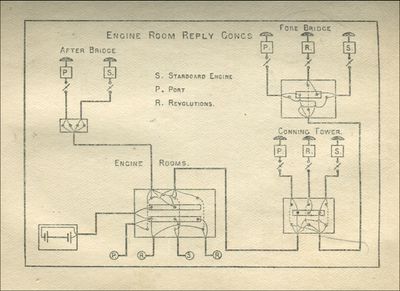Call Bell
Electrical Call Bells were used in Royal Navy ships as a means of calling between stations or to draw attention to new indications on instruments that might otherwise pass unnoticed.
Engine Room Reply Gongs
These single-stroke gongs were fitted 3 each in the fore bridge, conning tower, and after bridge so the engine room could quickly reply to orders received by port and starboard engine room telegraphs and the revolution telegraph.
Each gong had an on/off switch so that positions not in use could not be bothered by the gongs. Pushes in each engine room would ring the activated gongs of the appropriate type (both rooms could ring the revolution gong).[1] Power for the entire installation was supplied by a 6 cell battery up to 1905, at which time a motion was underway to convert to motor generator power.[2] This was still only mentioned as an initiative in 1908,[3] but by 1912 it was being done in recent ships.[4]
A new high voltage model of the single-stroke gong was created to better work with the generator-supplied power system.[5]
Trembler Bells and Indicating Shutters
Pattern 1297[6] trembler bells were used for all other communications, such as to call up the other end of a voicepipe. As it would be impossible to tell which of several nearby bells were ringing, a bell in a between a group or remote stations, and separate indicating shutters supplemented its ring to show which remote station was calling up. These were not necessary when a trembler bell served only 1 remote station.
The Pattern 1300[7] indicating shutters were housed in watertight boxes and actuated by electromagnets which would swing an indicating disc on an armature to be latched into a conspicuous position. A mechanical push located near the shutter would allow it to fall back to its disarmed state. In this way, the visible indication was "sticky" and would persist past the time when power to the shutter was removed.
The wiring was done so that the shutters of all stations in a group were all in series with a trembler bell.
Power and Wiring
As shown in Torpedo Drill Book, 1905.
Bells were wired and powered through 6 types of bronze or aluminum terminal boxes. Power was generally supplied by battery prior to 1905, at which time a motion was underway to convert to motor generator power.[8] By 1912, by 1914 the later ships were using motor generator power.[9]
| Pattern | Notes |
| 1541 | Connect 1 battery to 2 or more bell circuits |
| 1542 | 4 terminals. For stations with single push and bell, no shutter |
| 1543 | 5 terminals. As 1542, but with a shutter. |
| 1544 | 4 terminals. For 2 remote stations. |
| 1545 | 6 terminals. For 3 remote stations. |
| 1546 | 8 terminals. For 4 remote stations. |
Move to Buzzers
In 1908, the 12-in shell room of the King Edward VII class were using electric buzzers in lieu of the trembler bell.[10]
The move to motor generator supplied power necessitated the use of a new high voltage bell, Pattern 2237, as the old bell sparked excessively.[11]
See Also
Footnotes
- ↑ Torpedo Drill Book, 1905. p. 215.
- ↑ Torpedo Drill Book, 1905. p. 215.
- ↑ Torpedo Drill Book, 1908, p. 190.
- ↑ Torpedo Drill Book, 1912. p. 167.
- ↑ Torpedo Drill Book, 1908. p. 190.
- ↑ Torpedo Drill Book, 1905. p. 211.
- ↑ Torpedo Drill Book, 1905. p. 213.
- ↑ Torpedo Drill Book, 1905. p. 215.
- ↑ Torpedo Drill Book, 1912. p. 167.
- ↑ Torpedo Drill Book, 1912. p. 167.
- ↑ Torpedo Drill Book, 1908. p. 190.
Bibliography
- H.M.S.O., London Torpedo Drill Book, 1905 (Corrected to December, 1904). Copy in Tony Lovell's library.
- H.M.S.O., London Torpedo Drill Book, 1908 (Corrected to December, 1907). Copy in Tony Lovell's library.
- H.M.S.O., London Torpedo Drill Book, 1912 (Corrected to April, 1912). Copy in Tony Lovell's library.
- H.M.S.O., London (1914). Torpedo Drill Book, 1914 (Corrected to May 15) Copy in Tony Lovell's library.
